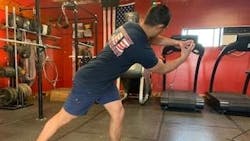The dictionary defines resilience as “able to withstand or recover quickly from difficult conditions.”
When it comes to firefighters, I believe that the single most important thing that we can focus on in regard to our health is to become more resilient. The reality is, because of the demands of the job and life, it isn’t a matter of if you will be injured or become sick, but when. Thus, how will you withstand or recover?
Seven years ago, I was told by an orthopedic surgeon that I needed back surgery. Luckily, I learned of the Foundation Training (FT) program. I didn’t get the surgery but instead used FT to help to recover from my injury.
I have been fortunate to work with hundreds of people at Los Angeles County Fire Department (LACoFD) as an IAFF peer fitness trainer. From new recruits to 30-plus-year firefighters, I have seen a countless number of people who were in pain. More importantly, I have seen a countless number of people get out of pain and increase performance using FT.
Why do firefighters need FT?
I define FT as an injury prevention and rehabilitation program that strengthens the posterior chain, decompresses the spine and reinforces proper body mechanics. A more firefighter friendly definition is resiliency training. Being resilient allows you to either recover quickly or continue to do what you love to do with less or no pain.
In addition, FT’s unique set of bodyweight positions teach you to leverage stress and force away from areas that are prone to injury (think joints at the neck, shoulder, back, hips and knees) and into areas that are better designed to absorb force (think muscles around those areas). By learning how to better leverage your body, you ingrain healthy movement patterns that bleed into everyday life activities, which reduces your risk of injury.
The answer to why you should use FT lies in the testing results of six firefighters. After receiving an introductory drill on FT, the firefighters were tested in four different areas before and after completing an online FT course. The eight-week program was five days per week for only 10 minutes a day. The areas that were tested were lung volume capacity, back strength, mental stress and global strength. Each one of these areas is significantly important to a firefighter’s health.
If we can increase lung volume capacity, it’s hypothesized that we potentially can reverse trends of respiratory illnesses that firefighters suffer.
According to the IAFF, back injuries account for approximately 50 percent of all line-of-duty injury retirements.
The stresses that firefighters face throughout the course of their career can have a cumulative effect on their mental health and well-being.
Lastly, as noted by fitness expert Mark Rippetoe, “Firefighters die on the job from heart attacks far more frequently than from any other cause, and there’s no better way to have a heart attack than to lack sufficient strength to complete a physical task that would have been easier and over with sooner if you were stronger.”
I call the four areas that firefighters were tested the R.E.S.T. Protocol: Respiration, Endurance, Stress and Tension.
What were the results? Every firefighter improved in each category. On average:
- Lung volume increased by 4.1 percent
- The times held for the McGill Torso Endurance Test increased by 282 percent in extension, 151 percent in flexion, 162 percent in the right plank and 103 percent in the left plank
- Perceived mental stress dropped by 40.6 percent
- Strength improved by 4.6 percent in the right hand and 6.4 percent in the left
FT’s four movements
The first movement is called supine decompression. It teaches you to create length and space in your torso. Lay on your back, hands near your hips with your palms down. Unlock the knees four inches and squeeze your thighs together. Bring the big toes together, separate the heels three inches and point your toes to your nose.
Next comes a style of breathing that’s unique to FT: decompression breathing. Take as big of a breath as you can into the front, sides and, in particular, the back of your ribcage. When you exhale, pull the abdomen in tight as you maintain the expansion of the ribcage.
The second movement, the founder, teaches you to load your hips instead of your spine when you bend over. Bring your feet shoulder distance apart and turn them in, so you are slightly pigeon-toed. Bring your arms out to your side and turn your thumbs away from one another. Press your feet firmly into the ground and stand as tall as possible without dropping your chin.
Next, continually push your hips back while you unlock your knees and allow your torso to lean forward until it’s at a 45-degree angle. Now, bring your arms out to chest height. Squeeze your heels toward one another and feel your inner thighs engage (without collapsing your knees). Pull your shoulders down toward your pockets, feeling your lats, or “pull up muscles,” turn on. Lastly, add the decompression breath.
The third movement, the woodpecker rotation, is similar to the founder but you hip-hinge using one leg and teaching your body to rotate at the hips. Bring your right foot forward and your left foot back the distance of a walking stride. Make sure that both feet are turned in slightly. Plant your right foot firmly; your left heel should be two inches off of the ground. Stand tall with your arms at your side with an even amount of weight on both feet. Continually push the right hip back as you lean the torso forward, transitioning a majority of your weight onto your front foot. Bring your arms out in front of your chest. Rotate your left hip toward your right knee. Let your shoulders, neck and head follow. Incorporate decompression breathing, then switch feet and repeat.
Lastly, for the eight-point plank, bring yourself onto all fours. Drop down to your elbows while keeping your palms and toes on the ground. Your elbows will be a few inches in front of the shoulders, and your knees will be behind your hips. Add the decompression breathing and squeeze your elbows and knees toward one another, then squeeze everything toward center.
Each day—six days per week for eight weeks—switch between Workout A and Workout B (below), which are performed in a pyramid format to the prescribed time. Workout A consists of the founder and the woodpecker rotation. Workout B consists of the supine decompression and the eight-point plank. If at any time during the workout you can’t hold perfect form, take a break and start again when you can.
- Workout A (Day 1)
Founder—10 seconds/Woodpecker rotation left/right legs—10 seconds
Founder—20 seconds/Woodpecker rotation left/right legs—20 seconds
Founder—30 seconds/Woodpecker rotation left/right legs—30 seconds
Founder—40 seconds/Woodpecker rotation left/right legs—40 seconds
Founder—50 seconds/Woodpecker rotation left/right legs—50 seconds
Founder—40 seconds/Woodpecker rotation left/right legs—40 seconds
Founder—30 seconds/Woodpecker rotation left/right legs—30 seconds
Founder—20 seconds/Woodpecker rotation left/right legs—20 seconds
Founder—10 seconds/Woodpecker rotation left/right legs—10 seconds
- Workout B (Day 2)
Eight-point plank—10 seconds/Supine decompression—10 seconds
Eight-point plank—20 seconds/Supine decompression—20 seconds
Eight-point plank—30 seconds/Supine decompression—30 seconds
Eight-point plank—40 seconds/Supine decompression—40 seconds
Eight-point plank—50 seconds/Supine decompression—50 seconds
Eight-point plank—40 seconds/Supine decompression—40 seconds
Eight-point plank—30 seconds/Supine decompression—30 seconds
Eight-point plank—20 seconds/Supine decompression—20 seconds
Eight-point plank—10 seconds/Supine decompression—10 seconds
It probably sounds as though I’m making FT out to be the be-all and end-all program, but I am the first to admit that it isn’t. FT is a tool in the toolbox. It is one piece of the puzzle of overall health and wellness. It’s meant to be used with other modalities in conjunction with one another for a greater total effect.
That said, as a firefighter for 15 years who has trained thousands of first responders, I have yet to find a program other than FT that addresses respiration, endurance, stress and tension. FT is an effective compound program that helps firefighters lead a healthier life with a decreased risk of the top health issues that plague this profession.
For more information, visit foundationtraining.com.
Evan Halquist
Evan Halquist has been a firefighter for 15 years and currently works at the Los Angeles County Fire Department as an engineer. As a Peer Fitness Trainer through the IAFF, he has worked with hundreds of firefighters, focusing on reducing pain and increasing performance through the use of Foundation Training and kettlebells.






